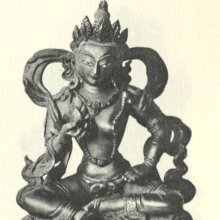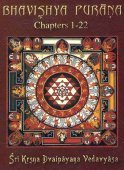Saptami, Saptamī: 8 definitions
Introduction:
Saptami means something in Hinduism, Sanskrit, Marathi, Tamil. If you want to know the exact meaning, history, etymology or English translation of this term then check out the descriptions on this page. Add your comment or reference to a book if you want to contribute to this summary article.
Images (photo gallery)
In Hinduism
Vyakarana (Sanskrit grammar)
Source: Wikisource: A dictionary of Sanskrit grammar1) Saptamī (सप्तमी).—The seventh case; the locative case; a term used for the locative case by ancient grammarians and Panini; cf. न सप्तम्यामन्त्रितयोः (na saptamyāmantritayoḥ) V. Pr. III 139; cf. ईदूतौ च सप्तम्यर्थे (īdūtau ca saptamyarthe) P. I. 1. 19. or सप्तम्यास्त्रल् (saptamyāstral) P. V. 3. 10; cf also द्वितीयादयः शब्दाः पूर्वाचार्यः सुपां त्रिकेषु स्मर्यन्ते (dvitīyādayaḥ śabdāḥ pūrvācāryaḥ supāṃ trikeṣu smaryante) Kas. on P. II. 3.2;
2) Saptamī.—The seventh of the moods and tenses; the optative mood; cf. Kat. III. 1. 20; Hemacandra III. 3. 7.

Vyakarana (व्याकरण, vyākaraṇa) refers to Sanskrit grammar and represents one of the six additional sciences (vedanga) to be studied along with the Vedas. Vyakarana concerns itself with the rules of Sanskrit grammar and linguistic analysis in order to establish the correct context of words and sentences.
Purana and Itihasa (epic history)
Source: archive.org: Shiva Purana - English TranslationSaptamī (सप्तमी) refers to the “7th day of a fortnight”, according to the Śivapurāṇa 2.2.15. Accordingly as Brahmā narrated to Nārada:—“[...] Firmly resolved in her desire to secure Śiva as her husband, she (viz., Devī as Satī) propitiated him in her own house with the permission of her mother. [...] On the seventh day [Saptamī] in the bright half of Pauṣa (December-January) Satī spent the night in keeping awake and worshipped Śiva in the morning with cooked rice and Kṛśara (jaggery mixed with gingelly seeds)”.

The Purana (पुराण, purāṇas) refers to Sanskrit literature preserving ancient India’s vast cultural history, including historical legends, religious ceremonies, various arts and sciences. The eighteen mahapuranas total over 400,000 shlokas (metrical couplets) and date to at least several centuries BCE.
Vaishnavism (Vaishava dharma)
Source: Pure Bhakti: Arcana-dipika - 3rd EditionSaptamī (सप्तमी) refers to one of the various “lunar days” (tithi):—There are approximately 29.5 lunar days in a lunar month. The first fifteen days begin with the first phase of the waxing moon (pratipat) and end with the full moon (pūrṇimā). [...] In accordance with the lunar day, one would utter, [for example, saptamī-tithau].

Vaishnava (वैष्णव, vaiṣṇava) or vaishnavism (vaiṣṇavism) represents a tradition of Hinduism worshipping Vishnu as the supreme Lord. Similar to the Shaktism and Shaivism traditions, Vaishnavism also developed as an individual movement, famous for its exposition of the dashavatara (‘ten avatars of Vishnu’).
Shaktism (Shakta philosophy)
Source: Brill: Śaivism and the Tantric Traditions (shaktism)Saptamī (सप्तमी) refers to the “seventh lunar day”, as part of the Navarātra Tantric ritual (an autumnal festival of the warrior goddess Caṇḍikā).—The sixth (ṣaṣṭhī) and the seventh (saptamī) lunar days involve awakening the goddess in a bilva tree (bodhana), worship of goddess as Cāmuṇḍā and Kālī in the branch, summoning her nine radiations in nine leaves (navapatrapūjā/patrikāpūjā), enlivening an unfired clay image of the goddess (prāṇapratiṣṭhā).—Various 8th century sources refer to such rituals, for example: Devīpurāṇa, Kālikāpurāṇa, Kṛtyakalpataru, Durgābhaktitaraṅgiṇī, Durgāpūjātattva, Durgāpūjāviveka, Bhadrakālīmantravidhiprakaraṇa in Sanderson (2007); account of the Durgā Pūjā in Kelomal, West Bengal (Nicholas 2013).

Shakta (शाक्त, śākta) or Shaktism (śāktism) represents a tradition of Hinduism where the Goddess (Devi) is revered and worshipped. Shakta literature includes a range of scriptures, including various Agamas and Tantras, although its roots may be traced back to the Vedas.
Languages of India and abroad
Marathi-English dictionary
Source: DDSA: The Molesworth Marathi and English Dictionarysaptamī (सप्तमी).—f (S) The seventh lunar day of either half-month. 2 In grammar. The seventh case.
Source: DDSA: The Aryabhusan school dictionary, Marathi-Englishsaptamī (सप्तमी).—f The 7th lunar day of either half- month. The 7th or locative case.
Marathi is an Indo-European language having over 70 million native speakers people in (predominantly) Maharashtra India. Marathi, like many other Indo-Aryan languages, evolved from early forms of Prakrit, which itself is a subset of Sanskrit, one of the most ancient languages of the world.
Sanskrit dictionary
Source: Cologne Digital Sanskrit Dictionaries: Monier-Williams Sanskrit-English Dictionary1) Saptamī (सप्तमी):—[from saptama > saptan] a f. See below.
2) [from saptan] b f. (of saptama above) the 7th Tithi or lunar day of the fortnight (on which day in the light fortnight there is a festival in honour of the 7th digit, of the moon; often ifc. See gaṅgā-s, jayantīs), [???; Mahābhārata; Varāha-mihira’s Bṛhat-saṃhitā] etc.
3) [v.s. ...] the 7th case id est. the locative or its terminations, [Nirukta, by Yāska; Vājasaneyi-saṃhitā-prātiśākhya] etc.
4) [v.s. ...] the potential or its terminations, [Kātantra]
5) [v.s. ...] a [particular] Mūrchanā, [Saṃgīta-sārasaṃgraha]
Sanskrit, also spelled संस्कृतम् (saṃskṛtam), is an ancient language of India commonly seen as the grandmother of the Indo-European language family (even English!). Closely allied with Prakrit and Pali, Sanskrit is more exhaustive in both grammar and terms and has the most extensive collection of literature in the world, greatly surpassing its sister-languages Greek and Latin.
Kannada-English dictionary
Source: Alar: Kannada-English corpusSaptami (ಸಪ್ತಮಿ):—
1) [noun] the seventh day following a full moon-day or new moon-day.
2) [noun] (gram) the seventh case indicating place at which or in which; locative case.
Kannada is a Dravidian language (as opposed to the Indo-European language family) mainly spoken in the southwestern region of India.
See also (Relevant definitions)
Starts with: Saptamika, Saptamipratirupaka, Saptamisamasa, Saptamisnapana, Saptamivibhakti, Saptamivrata, Saptamiya.
Ends with (+19): Acalasaptami, Achalasaptami, Arunodayasaptami, Bhahkarasaptami, Bhanusaptami, Bhaskarasaptami, Gangasaptami, Jahnusaptami, Jayantasaptami, Jayantisaptami, Kalyanasaptami, Kamalasaptami, Lalitasaptami, Mahasaptami, Mahatapahsaptami, Makarasaptami, Mandarasaptami, Mitrasaptami, Mittirasaptami, Nimittasaptami.
Full-text (+68): Rathasaptami, Vijayasaptami, Makarasaptami, Acalasaptami, Samipasaptami, Gangasaptami, Vidhanasaptami, Shitalasaptami, Mandarasaptami, Lalitasaptami, Sharkarasaptami, Mitrasaptami, Saptamika, Saptamivibhakti, Saputami, Rathasaptamikalanirnaya, Rathasaptamipuja, Rathasaptamivrata, Putrasaptamivratakatha, Rathasaptamisnanavidhi.
Relevant text
Search found 32 books and stories containing Saptami, Saptamī; (plurals include: Saptamis, Saptamīs). You can also click to the full overview containing English textual excerpts. Below are direct links for the most relevant articles:
Vedic influence on the Sun-worship in the Puranas (by Goswami Mitali)
Sun-worship Vratas (41) Vijayā-saptamī < [Chapter 5 - Rituals Related to the Sun-Worship in the Purāṇas]
Sun-worship Vratas (26) Pāpanāśinī-saptamī < [Chapter 5 - Rituals Related to the Sun-Worship in the Purāṇas]
Sun-worship Vratas (49) Sapta-saptamī-kalpa-vrata < [Chapter 5 - Rituals Related to the Sun-Worship in the Purāṇas]
Garga Samhita (English) (by Danavir Goswami)
Verses 3.10.28-30 < [Chapter 10 - The Glory of Śrī Girirāja]
Verses 3.10.31-37 < [Chapter 10 - The Glory of Śrī Girirāja]
The Garuda Purana (by Manmatha Nath Dutt)
Chapter CXXX - The Shashti Vratas, Maricha Saptami Vratas < [Brihaspati (Nitisara) Samhita]
Vakyapadiya of Bhartrihari (by K. A. Subramania Iyer)
Verse 3.7.86 < [Book 3 - Pada-kāṇḍa (7): Sādhana-samuddeśa (On the Means)]
Verse 3.7.44 < [Book 3 - Pada-kāṇḍa (7): Sādhana-samuddeśa (On the Means)]
Verse 3.14.549-550 < [Book 3 - Pada-kāṇḍa (14): Vṛtti-samuddeśa (On Ccomplex Formation)]
The Padma Purana (by N.A. Deshpande)
Chapter 21 - The greatness of Puṣkara and some important vows < [Section 1 - Sṛṣṭi-khaṇḍa (section on creation)]
Chapter 77 - The Vow of Saptamī in Houour of the Sun < [Section 1 - Sṛṣṭi-khaṇḍa (section on creation)]
Chapter 13 - The Importance of the Vow of Janmāṣṭamī < [Section 4 - Brahma-khaṇḍa (Section on Brahman)]
The Skanda Purana (by G. V. Tagare)
Chapter 56 - Greatness of Sāṃbāditya < [Section 1 - Tīrtha-māhātmya]
Chapter 162 - Procedure of Puraścaraṇa Saptamī < [Section 1 - Tīrtha-māhātmya]
Chapter 313 - Greatness of Uttarārka < [Section 1 - Prabhāsa-kṣetra-māhātmya]
Related products

